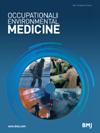Cumulative occupational exposure to gases and fumes is associated with impairment in lung function and disease-related quality of life in a German COPD patient cohort
IF 3.9
2区 医学
Q1 PUBLIC, ENVIRONMENTAL & OCCUPATIONAL HEALTH
引用次数: 0
Abstract
Objectives The impact of occupational exposures on lung function impairments and quality of life (QoL) in patients with chronic obstructive pulmonary disease (COPD) was analysed and compared with that of smoking. Methods Data from 1283 men and 759 women (Global Initiative for Chronic Obstructive Lung Disease (GOLD) grades 1–4 or former grade 0, without alpha-1-antitrypsin deficiency) of the COPD and Systemic Consequences Comorbidities Network cohort were analysed. Cumulative exposure to gases/fumes, biological dust, mineral dust or the combination vapours/gases/dusts/fumes was assessed using the ALOHA job exposure matrix. The effect of both occupational and smoking exposure on lung function and disease-specific QoL (St George’s Respiratory Questionnaire) was analysed using linear regression analysis adjusting for age, body mass index, diabetes, hypertension and coronary artery disease, stratified by sex. Results In men, exposure to gases/fumes showed the strongest effects among occupational exposures, being significantly associated with all lung function parameters and QoL; the effects were partially stronger than of smoking. Smoking had a larger effect than occupational exposure on lung diffusing capacity (transfer factor for carbon monoxide) but not on air trapping (residual volume/total lung capacity). In women, occupational exposures were not significantly associated with QoL or lung function, while the relationships between lung function parameters and smoking were comparable to men. Conclusions In patients with COPD, cumulative occupational exposure, particularly to gases/fumes, showed effects on airway obstruction, air trapping, gas uptake capacity and disease-related QoL, some of which were larger than those of smoking. These findings suggest that lung air trapping and QoL should be considered as outcomes of occupational exposure to gases and fumes in patients with COPD. Trial registration number [NCT01245933][1]. Data are available upon reasonable request. Approval by all relevant human research ethics committees will be required. [1]: /external-ref?link_type=ISRCTN&access_num=ISRCTNNCT01245933在德国慢性阻塞性肺疾病患者队列中,累积性职业接触气体和烟雾与肺功能损害和与疾病相关的生活质量有关
目的 分析职业暴露对慢性阻塞性肺病(COPD)患者肺功能损伤和生活质量(QoL)的影响,并与吸烟的影响进行比较。方法 对慢性阻塞性肺病和系统性后果合并症网络队列中的 1283 名男性和 759 名女性(慢性阻塞性肺病全球倡议(GOLD)1-4 级或以前的 0 级,无α-1-抗胰蛋白酶缺乏症)的数据进行了分析。气体/烟雾、生物粉尘、矿物粉尘或蒸汽/气体/粉尘/烟雾组合的累积暴露使用 ALOHA 工作暴露矩阵进行评估。采用线性回归分析方法分析了职业暴露和吸烟暴露对肺功能和疾病特异性 QoL(圣乔治呼吸系统问卷)的影响,并按性别对年龄、体重指数、糖尿病、高血压和冠状动脉疾病进行了调整。结果 在男性职业暴露中,接触气体/烟雾的影响最大,与所有肺功能参数和 QoL 都有显著相关;部分影响强于吸烟。与职业暴露相比,吸烟对肺扩散能力(一氧化碳转移因子)的影响更大,但对空气截留(残留容积/总肺活量)的影响不大。在女性中,职业暴露与 QoL 或肺功能无显著相关性,而肺功能参数与吸烟之间的关系与男性相当。结论 在慢性阻塞性肺病患者中,累积的职业暴露,尤其是气体/烟雾暴露,会对气道阻塞、空气截留、气体摄取能力和疾病相关的 QoL 产生影响,其中一些影响大于吸烟的影响。这些研究结果表明,慢性阻塞性肺病患者在职业暴露于气体和烟雾时应考虑肺部空气截留和 QoL。试验注册号[NCT01245933][1]。如有合理要求,可提供相关数据。需要获得所有相关人类研究伦理委员会的批准。[1]:/external-ref?link_type=ISRCTN&access_num=ISRCTNNCT01245933
本文章由计算机程序翻译,如有差异,请以英文原文为准。
求助全文
约1分钟内获得全文
求助全文
来源期刊

Occupational and Environmental Medicine
医学-公共卫生、环境卫生与职业卫生
CiteScore
8.30
自引率
2.00%
发文量
98
审稿时长
2 months
期刊介绍:
Occupational and Environmental Medicine is an international peer reviewed journal covering current developments in occupational and environmental health worldwide. Occupational and Environmental Medicine publishes high-quality research relating to the full range of chemical, physical, ergonomic, biological and psychosocial hazards in the workplace and to environmental contaminants and their health effects. The journal welcomes research aimed at improving the evidence-based practice of occupational and environmental research; including the development and application of novel biological and statistical techniques in addition to evaluation of interventions in controlling occupational and environmental risks.
 求助内容:
求助内容: 应助结果提醒方式:
应助结果提醒方式:


